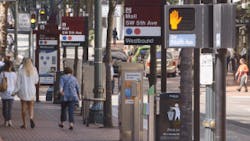TriMet to make MAX service more efficient
The TriMet Board of Directors voted to consolidate stations in downtown Portland to make the MAX Blue and Red lines more efficient.
The board approved an ordinance closing the Mall/SW 4th Ave and Mall/SW 5th Ave stations permanently on March 1, 2020. The board approved a pilot closure of the Kings Hill/SW Salmon St Station for one year, also beginning March 1, 2020, after which time TriMet will reevaluate if the station should be removed permanently. The closure of a fourth station, the Skidmore Fountain Station, which had been previously discussed, will be reevaluated in 2022 to determine if weekday ridership increases and proposed development in the area occurs.
Efficient and equitable transit service
TriMet’s consolidation of MAX stations in downtown Portland is an important part of the efforts to speed up transit and provide service that is efficient and equitable.
It takes MAX Blue and Red Line trains 22 minutes to travel the 3 miles between Goose Hollow/SW Jefferson St and Lloyd Center/NE 11th Ave stations. In the neighboring segments, it takes trains half that time to go 5 miles.
Closing the Kings Hill, Mall/SW 5th and Mall/SW 4th stations will cut that travel time by about 11 percent. For riders, that’s 3 minutes saved a day and 13 hours saved a year.
Not only will trips be more efficient for riders who go in and out of downtown Portland but it will also give the 10,000 riders who travel through downtown each day, half a day back each year.
Station spacing to speed up trains
In developing the consolidation proposal, TriMet staff looked at stations in downtown Portland that were extremely close together and had ridership lower than the nearby alternatives. The four stations that had been identified for closure were all about two train lengths from other, more consistently used stations.
During their research, staff conducted an informal survey of other rail systems in North America. They found that no other city has stations that close together, with most cities spacing stations at least a half-mile apart to balance speed and access. Also, TriMet’s bus system, with more than 6,600 stops, has just less than seven percent of stops within 500 feet of an alternative.
Community feedback helped shape station consolidation
TriMet conducted 10 months of outreach and engagement to get feedback from neighbors, community members and customers. There was little opposition about closing the Mall/SW 5th and Mall/SW 4th stations. Community groups and neighboring businesses raised concerns about closing the Kings Hill and Skidmore Fountain stations. Riders in online and on-board surveys mostly supported the closures, with nearly seven in 10 saying they want a faster trip.
Station consolidation costs
TriMet estimates that the station closures will lead to some $460,000 in signal system upgrades to move trains more efficiently through downtown. Up to $750,000 in costs are also expected to remove the stations and convert the areas for other use. Some of those costs will likely be offset as more people ride the improved service and operational/maintenance costs related to the stations are eliminated.
Making transit better
Consolidating the stations on the MAX Blue and Red lines is just one of the ways TriMet is speeding up transit and making it an attractive alternative to driving alone. TriMet continues to make major improvements, kicked off in 2016, to rejuvenate the MAX system including the Lloyd MAX Improvements in August to upgrade switches and sections of track. TriMet has made improvements to the overhead wire system and added anchors to rail ties to reduce heat-related delays on the MAX Blue, Red and Yellow lines.
TriMet is working with Metro and cities and counties across the region on strategic efforts to move buses around congestion. TriMet continues its largest expansion of bus service in history, a multi-year effort to add buses at more times, serve new areas and decrease the wait times.
